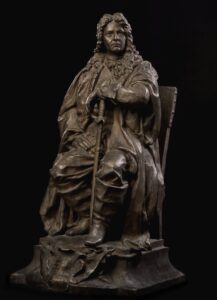
Colonel De Heer Abraham De Peyster, modeled ca. 1893, George Edwin Bissell, Smithsonian American Art Museum
Abraham De Peyster (de Peijster), Mayor 1691-1694: De Peyster (1657 – 1728) was a colonel, enslaver, merchant in the slave trade, and imported southern European wines, brandy, and “fancy stuffs.”[1] De Peyster was one of the most active and richest merchants in New York City around 1700, likely second only to Rip Van Dam in shipping activity and wealth, and the leading importer of wine. He likely served as acting governor of the Province of New York during 1700–1701 and was the Chief Justice of the Supreme Court of Judicature in 1701 and 1702.
He was an investor in two ships that transported enslaved people. John and Anne brought an unknown number of enslaved people to New York from the Caribbean from 1717 to 1718 and New York Pink carried one enslaved person to Maryland in 1720. He also spent £315 in 1698 to buy the Hester, a vessel seized by the government, and held a quarter share of the ship William and Mary.[2]
He had nine enslaved people in his household in New York City in the c.1703 census. In his will, he does not mention enslaved people, but he leaves fifty pounds to his servant Hannah Krugers and thirty more pounds if she lived with his wife until she is deceased. By the time the will was proved in April 1734 many people mentioned in the will were dead.[3]
On April 1, 1691, there is a bill to the King’s Council of New York from Dr. Thornhill and Dr. Kelsoe for their care of “men that were killed in their Majesties service against Lisseler and his accomplices.” This includes “care for Mrs. DePeyster’s negro of a gunshot wound” and “weuing the body of Mr. DePeyster’s negro.”[4] Abraham De Peyster and his brother Johannes were captains of militia companies during Leisler’s Rebellion (1689-1691). These enslaved men were part of a militia company led by Richard Ingoldsby in March 1691 that retook the fort from Leisler. It is likely that the other enslaved man belonged to their mother, Cornelia, as their father Johannes died in 1685.
Investments in Ships that Transported Enslaved
| Ship | Dates of Voyage or in NY Port | Ports of Call | Enslaved Purchased | Cargo | Co-Investors |
| John and Anne | 8/5/1717 | Nevis | unknown | Sugar, molasses, coconuts | Two sons of other mayors: Judge Samuel Bayard and Gerrardus Beekman |
| John and Anne | 5/14/1718 | Curaçao | 2 | Chocolate, coconuts, skins, other cargo | Judge Samuel Bayard, Rip Van Dam, and John Read |
| John and Anne | 8/26/1718 | Barbados | 11 | Rum | Judge Samuel Bayard, Rip Van Dam, and John Read |
| New York Pink | 11/18/1720 | To Maryland | 1 | 13 casks rum, nine casks sugar, 19 casks molasses, lime juice, chocolate, and provisions | Andrew Freneau, Thomas Bauyeaux, and Garrett Vanhorne |
[1] Merchants & Empire, p.60, 137
[2] Conquest and Change, Kindle edition, Ch. 3, location 7093
[3] Abstracts of wills on file in the Surrogate’s Office, City of New York, Vol. III, p.142 FamilySearch; Memorial History of the City of New-York, 1892, Columbia Univ. press; c.1703 census, NYC East Ward, U.S. Census Bureau, list
[4] The documentary history of the State of New-York…, Vol. II, p.364
Ship investments: 107291, Donnan p.464, CO 5/1222_03, 119; #107333, p.466, CO 5/1222, 159; #107357, p.468, 5/1222_04, 174; #107401, CO 5/1222_005, 242
Copyright 2025 Paul Hortenstine



